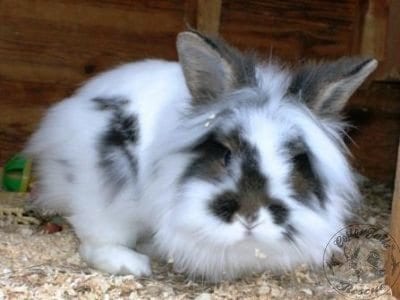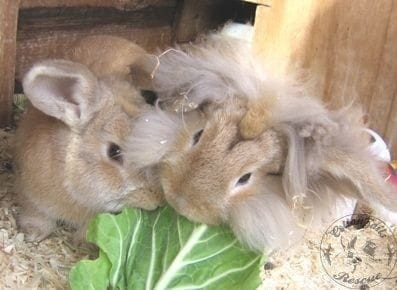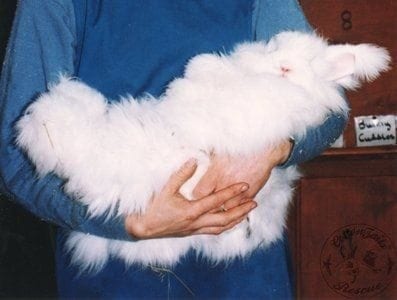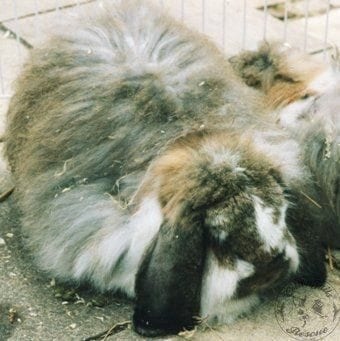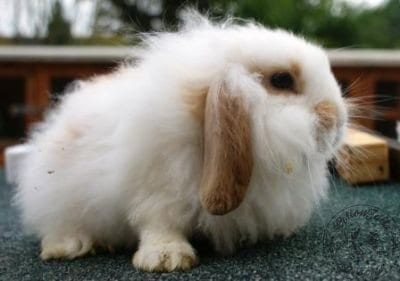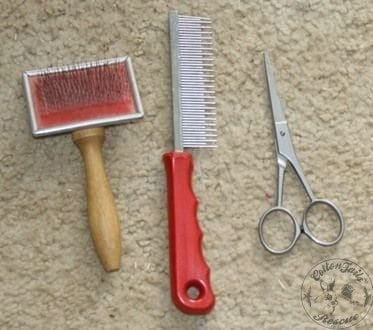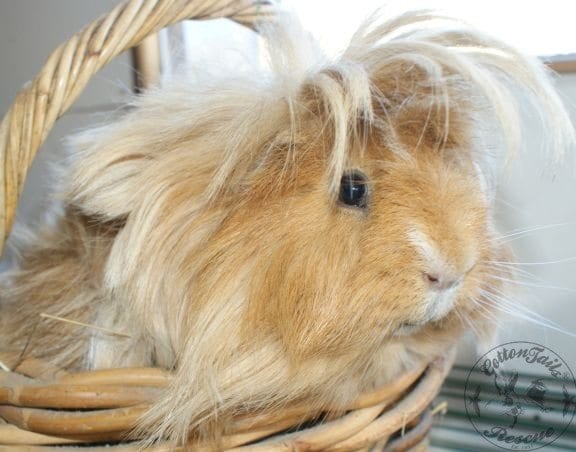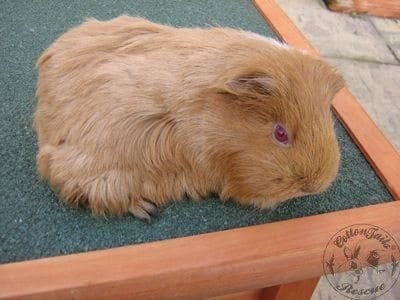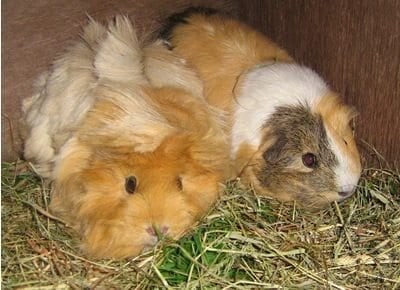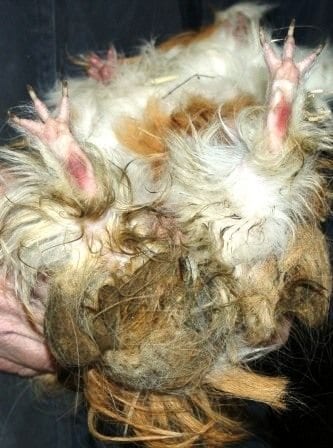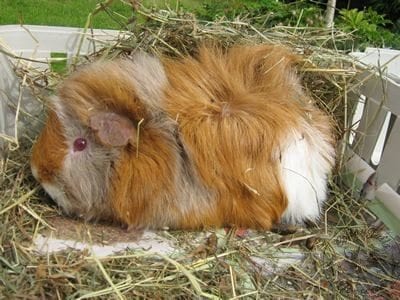How many of us have fallen for a beautiful fluffy baby rabbit or guinea pig and bought it on impulse without giving any thought about coping with the fur? Far too many of us I suspect! It’s not long before such a gorgeous creature becomes a real chore, with tight matts forming all over the body and the resulting dirty tail giving a high risk of flystrike. However, help is at hand!
Long-Haired Rabbits
Unless you intend to exhibit your rabbit, the most straightforward way to manage long fur that frequently matts is to keep it cut short. Bearing in mind that rabbits were not meant to be long-haired, your rabbit will thank you for ridding him of the weight as well as preventing the excess heat long fur generates (especially in the summer), and enable him to groom properly again. Furthermore, most rabbits hate being brushed, and although some will learn to tolerate the procedure, it makes much more practical sense to return the fur to the length it was meant to be in the first place. Just to clarify the situation, this does not apply to Lionhead breed, as proper lionheads only have fringes around the head, shoulders and around the rump area, and should not have lots of fluffy fur anywhere else. This type of rabbit is illustrated below and usually does not pose much of a problem, apart from the need to occasional detangle the fringes from twigs or bedding.
Angora-type rabbits or cashmere’s with excess wool in the coat do, however, present major problems, such as the breeds shown in the photos below:
You have three choices about how to manage the fur:
1. Use basic equipment such as a double-bladed cat comb, a brush (various types), and a pair of short-bladed sharp scissors.
2. Invest in a set of electric clippers, using a special angora blade.
3. Book the rabbit in to the vets or the local dog clipping salon and have the professionals tackle the job for you.
The first option is only viable if you are able to handle your rabbit firmly and keep him still whilst you go about the task. Do not even attempt to go ahead if this is not the case as you could easily end up chopping off a tail or cutting into the skin with disastrous results. The comb, brush and scissors method is particularly useful for small areas of matting such as around the tail. There is also a fur stripping de-shedding grooming tool that is available from vets and some pet stores, but it does not work well on matted fur and is of most use to remove old fur from a normal coated rabbit during a moult.
Before you start, you may wish to wash the area first if the rabbit is covered in sticky droppings, as it can be difficult to see what you are doing if the area is plastered with goo. Persistent soft droppings are often linked to inadequate diet, so if this continues to be a problem after the rabbit has been tidied up, this needs to be looked at as a separate issue. On the basis that you are ready to start stripping a matted rabbit, hold the rabbit comfortably on your knee, holding him almost upside down with his head resting on your left arm (if you are right handed) as shown in the photo below.
I then conduct a thorough examination of the matted area to make sure I know exactly where all the parts of the anatomy are, including feet and tail, and then gently start snipping underneath the mats taking great care at all times to snip above the skin. Some mats are very close to the skin so you must take time and slowly and gently slip the scissors in the gap between skin and fur and nibble and tease away until you free the matted fur so it can be removed. I often use a combination of scissors and comb and work away at an area until it is cleared, and then move on to the next area. You often end up with what appears to be more fur on the table than on the rabbit (see photo below)!
Sometimes you need to vary the position of the rabbit so you can get the best access for the particular part of the body that you are working on at the time. A tricky area to work on is the dewlap (the pouch underneath the chin of some rabbits, especially common in females), as you have to position the rabbit correctly and this is not very easy, especially if you are not used to handling rabbits very much. I find that some of the dewlap can be reached by sitting the rabbit on your knee in the usual upright position and work from the shoulders inwards, but the area in the very centre (directly underneath the chin) is often only reached by having the rabbit upside down on your knee with the hind legs nearest you and the head furthest away.
Strangely enough, many rabbits will lie in this position for quite a while, and so long as you work slowly and gently you should be able to finish the task before he “wakes up” and decides that enough is enough!
The second option is to use a set of clippers. You are best to buy clippers that are specially made for use on animal fur, as human clippers do not cope very well with the wool in the coat of a fluffy rabbit. Purchase an angora blade at the same time and this will make the job easier. Clippers are very useful if the whole rabbit needs to be stripped down. The first option (scissors and comb) can be used in conjunction with the clippers for the tricky areas such as around the tail and face if the clippers can’t be used in those areas safely. Practice on an easy bit first until you feel confident to go ahead. It is easier to place the rabbit on a table with a non-slip top and work from there when using clippers, but make sure the power cable is carefully out of reach of nibbling teeth! The photo below shows rabbits after they had been clipped.
The third option is to book the rabbit into a vet or professional dog grooming salon and let them sort out the problem, although you will pay a fairly high fee for the privilege and this will need to be repeated several times in a year. Some vets will suggest sedation prior to the clipping, which enables them to strip the rabbit down very quickly and reduces the stress factor for the bunny concerned. However, rabbits can get used to routines and if they need to be stripped down regularly some will soon learn to sit still and put up with it. Not all dog grooming salons will clip rabbits, so make enquiries and take it from there. Some offer mobile services and will come to your home, and this has the advantage of not causing the rabbit additional stress by having a journey first. Some rabbit rescues will also carry out grooming and de-matting, often for just a reasonable donation, so they are worth considering too if you really feel you can’t strip the rabbit down yourself.
If for any reason you are not able or willing to have your long-haired rabbit groomed regularly, it may be best all round to consider finding him or her a new home where the bunny will have the proper care and attention he needs.
Before you consider any of the above options, you need to bear in mind what time of year it is, as an angora that is kept outside will really feel the cold if you strip it down to the wood in the middle of winter! If the rabbit is kept inside, this is not so much of an issue. Also, don’t necessarily expect to get the whole rabbit done in one sitting, as some rabbits will only tolerate ten minutes or so of de-matting, others will lie comfortably for half an hour or more. It is best to split the task into manageable sessions, rather than risk stressing the rabbit too much and ending up with gut stasis or other stress-related condition.
Long-Haired Guinea Pigs
The good news is that long-haired guinea pigs are far easier to cope with than fluffy long-haired rabbits! The fur does not become woolly so does not develop the same severity of matting that an angora-type rabbit will, but the tangles can still be bad enough to need regular attention. The photos below illustrate guinea pigs that need a bit of extra TLC:
I never use clippers on guinea pigs as I prefer to use the small bladed scissors and the cat comb to tease out any matts and tangles. They are relatively easy to remove, just ease the scissors between the skin and the matted fur and gently nibble away until the matt is freed for removal. Most of the matts tend to be around the rump area, but you can also get some forming on the tummy and around the legs, so you need to be able to gently turn the guinea pig upside down to get access to these tricky areas. As with rabbit grooming, make sure you know where all the “bits” are before you start snipping! Below are photos of guinea pigs after they have had their short-back-and-sides.
The photo below shows what a serious situation it is to own a long haired guinea pig and not keep the fur in check. Not only did this guinea pig have a massive heavy smelly lump attached to him, but in the summer months he could easily have died from fly strike as the flies could have laid eggs in the “attractive” mass.
There are many different breeds of guinea pigs, and some are semi long-haired so only need a trim every 3-4 weeks around the rump area to keep them neat, tidy and clean. This only takes a couple of minutes and is quite easy to do. An example of this type of piggy is below – he is an Abyssinian crossbred, hence the rosettes in his fur.
I hope this article helps you to groom your furry friends correctly and gives you the confidence to know that you CAN cope!


